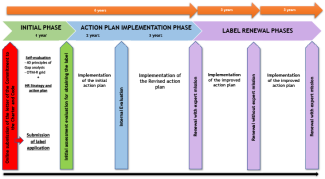What is the European Human Resources Strategy for Researchers (HRS4R) ?
REGULATORY ENVIRONMENT :
The European Human Resources Strategy for Researchers (HRS4R) aims to improve the practices of research organisations and institutions in terms of researcher recruitment and working conditions.
It is the subject of an "HR Excellence in Research" label awarded by the European Commission to institutions committed to this approach.
This label recognizes institutions that have signed the "European Charter for Researchers" and the "Code of Conduct for the Recruitment of Researchers", published in 2005 to promote researcher mobility and careers and make the European Research Area (ERA) more attractive in terms of recruitment and working conditions for researchers worldwide.
The Charter and the Code are tools that promote the research profession. They focus on career development and mobility, and list good practices in recruitment.
What are the benefits of participating in the HRS4R initiative ?
By officially embarking on the HRS4R labeling process in late March, Artois University reaffirms its commitment to implementing the HRS4R strategy in order to contribute to the development of the European Research Area (ERA) by promoting researcher mobility and career development.
The University seeks to join the 716 institutions and organisations, including 64 in France (as of January 25, 2024), that have already committed to the HRS4R process.
AIMS OF THE INITIATIVE :
- To demonstrate that the institution adheres to and implements actions to address and apply the Charter and Code;
- To demonstrate that the institution values researchers' careers;
- To develop a continuous improvement approach to human resource management for research institutions.
ADDED-VALUE FOR ARTOIS UNIVERSITY :
- To provide researchers with a supportive work environment;
- To enhance our credibility (internal/external) and attractiveness to European and international researchers (HR quality guarantee);
- To increase our visibility on a European and international scale;
- To improve the response to European project calls by highlighting the label.
BENEFITS FOR RESEARCH PERSONNEL :
Being awarded the HR Excellence in Research label signifies a commitment to quality for research personnel, enabling them to :
- Benefit from a comprehensive set of recruitment procedures that ensure an open, transparent, and merit-based recruitment process;
- Thrive in a professional environment that prioritises work-life balance;
- Engage in continuous professional development through a wide range of training opportunities;
- Receive guidance on ethical and deontological practices;
- Receive support in pursuing European research grants.
Presentation of the label :
The HRS4R initiative is a comprehensive process aimed at improving human resource (HR) practices and working conditions for research personnel while simultaneously enhancing the attractiveness of research careers. Engaging in the HRS4R labeling process represents a long-term commitment undertaken voluntarily by the institution.
This label encompasses 40 principles structured around four key themes aligned with the charter and code :
- Ethical principles and professional responsibilities;
- Recruitment, career development, and mobility;
- Working conditions and safety, professional environment;
- Training.
OVERALL LABELING PROCESS BY THE EUROPEAN COMMISSION :
Given that the HRS4R initiative is a European quality process, all communication with the European Commission and the documentation to be provided must be in English.
LAUNCH OF THE INITIAL PHASE :
The institution submits the letter of commitment to the charter and code and undertakes to implement the HRS4R approach.
The European Commission (EC) verifies the approval letter and sends the confirmation back to the institution within 10 working days.
The institution must submit to the European Commission the Gap Analysis, the OTM-R checklist and the initial action plan in English (12 months after the confirmation letter).
Self-evaluation (Gap Analysis and OTM-R Checklist)
Gap Analysis addresses the questions "where are we?" and "where do we want to be?". It outlines the necessary improvements and identifies gaps and challenges to address.
The OTM-R checklist (Open, Transparent, Merit-based Recruitment):
This checklist serves as a self-evaluation of the institution's practices and policies to enhance career appeal, promote mobility, and provide equal opportunities for all applicants.
Definition of HR Strategy and Action Plan
The Action Plan is a sequence of activities that must be carried out to transition from the institution's current model to the target in relation to the C&C.
Experts will provide their feedback on the application three months after submission :
- Approved: The institution is granted the label and proceeds to the implementation phase
- Approved with minor revisions: The institution has two months to resubmit the application
- Rejected: The institution has 12 months to resubmit.
Upon receiving the label, the institution proceeds to the implementation phase of the established action plan.
If the application passes the administrative eligibility check, the European Commission will send the files to external evaluators (this can take up to 2 months).
There will therefore first be an administrative validation (of the documents provided).
The 3 evaluators will establish the initial evaluation report by consensus, which will be communicated to the institution by the EC.
The institution will have access to the consensus report approximately three months after the confirmation of the administrative eligibility check.

